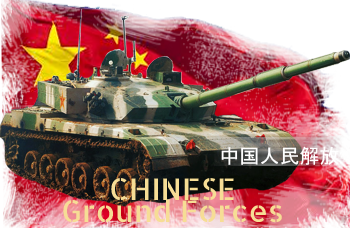 About 11,000+ AFVs 1990-2017
About 11,000+ AFVs 1990-2017
Tanks
 Type 96
Type 96 Type 90-II
Type 90-II Type 98 (ZTZ-98)
Type 98 (ZTZ-98) Type 99 (ZTZ-99, 99km)
Type 99 (ZTZ-99, 99km) Type 99A
Type 99A ZTQ-15 (Type 15)
ZTQ-15 (Type 15) VT-2 MBT
VT-2 MBT VT-4 MBT
VT-4 MBT VT-5 MBT
VT-5 MBTAPC/IFVs
 ZBD-97
ZBD-97 ZBD-2000
ZBD-2000 ZBD-03
ZBD-03 ZBD-04
ZBD-04 ZBD-05
ZBD-05 ZBD-09
ZBD-09 ZBL-08 APC
ZBL-08 APC WZ 503 APC*
WZ 503 APC* WZ 504 Tank Hunter*
WZ 504 Tank Hunter* WZ 501A IFV*
WZ 501A IFV* WZ 505 ambutank*
WZ 505 ambutank* WZ 506 Command*
WZ 506 Command* Type 86B Amph.Tank
Type 86B Amph.Tank Type 89 IFV
Type 89 IFV Type 86G IFV
Type 86G IFV*Based on the Type 86 IFV.
Wheeled APCs
 WZ551
WZ551 BJ-2020
BJ-2020 Shaanxi Baoji Tiger APC
Shaanxi Baoji Tiger APCSelf Propelled Artillery.
 PZL-05
PZL-05 QSL-92 AT
QSL-92 AT ZSD-89-II
ZSD-89-II ZTL-11
ZTL-11 PLL-09
PLL-09 Type 09 AARV
Type 09 AARV Type 07P
Type 07P ZBD-04A AT
ZBD-04A AT GZM
GZM FM-90/HQ-7B
FM-90/HQ-7B PLZ-82/83
PLZ-82/83 PLZ-07 SPH
PLZ-07 SPH PHZ-89 RML
PHZ-89 RML PLZ-09 SPH
PLZ-09 SPH PLL-05 SPH
PLL-05 SPH Type 83 SPH
Type 83 SPH W90 SPG
W90 SPG Type 70 SPH
Type 70 SPH PHL-81/90 MRL
PHL-81/90 MRL SR-5 MRL
SR-5 MRL PHZ-11 MRL
PHZ-11 MRL PHL-03 MRL
PHL-03 MRL Hongyan OQ261
Hongyan OQ261 PGZ-09
PGZ-09 PGZ-95
PGZ-95 PGZ-88
PGZ-88 Type 92 Yitian
Type 92 Yitian Type 80 SPAAG
Type 80 SPAAG Type 85 SPAAG
Type 85 SPAAG LD-2000 SPAAG
LD-2000 SPAAG SA-2 75mm SPAAG
SA-2 75mm SPAAG BK1060 35mm SPAAG
BK1060 35mm SPAAG CS/SA-1 SPAAG
CS/SA-1 SPAAG Type 09 AARV
Type 09 AARV CSK-131
CSK-131 CSK-141
CSK-141 YJ2080
YJ2080 CSK-181
CSK-181 CS/VP4
CS/VP4 8M 4x4
8M 4x4 CS/VP3
CS/VP3 CS/VN3
CS/VN3 CS/VN3
CS/VN3 ZFB-05
ZFB-05 GQL-111 AVLB
GQL-111 AVLB GCZ-110 ARV
GCZ-110 ARV Type 653 ARV
Type 653 ARV Type 59G MBT
Type 59G MBT QN-506
QN-506 Type 73 ARV
Type 73 ARV Type 59 HIFV
Type 59 HIFV Type 84 AVLB
Type 84 AVLB
The Chinese Tanks in the cold war
 Type 59 Tank
Type 59 Tank Type 62 Tank
Type 62 Tank Type 63 APC
Type 63 APC Type 63 Tank
Type 63 Tank Type 69 Tank
Type 69 Tank Type 77 Tank
Type 77 Tank Type 80 Tank
Type 80 Tank Type 85 AFV
Type 85 AFV Type 85 Tank
Type 85 Tank Type 86 IFV
Type 86 IFV Type 89 TD
Type 89 TD HQ-7/FM-80 P20 TELAR
HQ-7/FM-80 P20 TELAR
Chinese softskin Vehicles: Trucks, Tractors and Cars
Facing new challenges
The fall of USSR somewhat relieved the Chinese PLA of the traditional threat of a war on its northern borders, but with the new world order emerging in the 2000s, the Grounds forces were consistently improved and geared towards quality for costly MBTs, while quantity shifted towards cheaper wheeled vehicles while the emphasis was put on export, with success.Modernization of the PLA's armor
By fact, the PLA deploys today the world's largest ground force, with 1.6 million personnel (60% of the PLA's total manpower), divided among seven military regions. The PLAGF reserve had a 510,000 personnel divided between infantry and anti-aircraft artillery (AAA) divisions. Two amphibious mechanized divisions are based in Nanjing and Guangzhou districts. 40% of PLA divisions and brigades are now mechanized or armored, thanks to a reduction of size to bolster economic growth, which favored the army core of motorized elements.The latest operational doctrine integrates information technology, electronic and intelligence as well as long-range precision strikes. An integrated battlefield information network with (LAN/WAN) communications, satellite communications, and UAV-based surveillance/recce is set up, as well as mobile command and control centers. The bulk of the armored divisions is equipped with Type 96 and 90 tanks, whereas the Type 80/85/88 and older types are now in the active reserve. The Type 99 is reserved only for elite battalions.
Equipment of the PLAN
While there are an estimated 8,000 tanks in reserve today kept in case of war, they are of the now obsolete 1st and 2nd generation Chinese MTBs: Type 59s of the late type (total circa 10,500, but less than 1,000 Type III), with Type G conversion kits and possibly spare turrets, Type 69 and Type 79 models (about 3,000), the Type 80/88 (circa 3,500), the Type 85 (circa 600) and Type 90s (circa ) in second line units. But the bulk of the army's armoured divisions is made of the Type 96 main battle tank, of which are estimated 2,000 in service. This main force is completed by a few guards, elite units equipped with the Type 99. Only around 300 of the latter are in service.The Type 90-IIIM the ancestor of the Type 96 (1990).
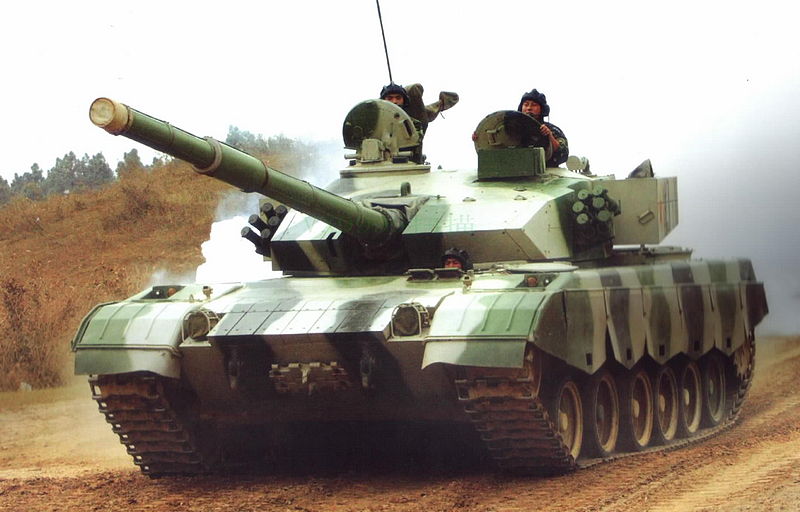
The 1997, 3rd generation tank developed from the Type 85 type III, is the Type 96, with around 2,077 produced according to the latest data.
Main Battle Tanks
Interesting new developments: Two new MBTs and a new light tank
 Type 99A (ZTZ-99A) MBT
Type 99A (ZTZ-99A) MBT
ZTZ-99A, the latest Chinese main battle tank (published on reddit's "tank porn" section).
Indeed, apart of the ZTZ-99 we covered there already, the improved A version and the brand new ZTQ light tank are 2000s developments that are intended to renew completely the remainder of the modernized park of 1960-70s machines. Nowadays, the lite is represented by the ZTZ-99A and older ZTZ-99 roughly 1000 tanks, while the bulk is made with 3,000 ZTZ-96s (upgraded to the G version) and the whole range of light tanks (The venerable Type 62 or the amphibious Type 63 and type 77) by the ZTQ-15 and its future derivatives. As a cheaper tank compared to the VT series, the ZTQ present great export opportunities and the VT-5 has been developed in this direction.

ZTZ-99: The already old elite MBT received some upgrades like the 2000s KM version, but it had been produced in limited numbers and has never been exported. The task is reserved to the current VT-4 family based on upgraded Type 96G versions. It is understood that there are critical Chinese-developed components that they are not willing to share. Total production is now estimated about 900, including the Type 98 pre-serie prototypes, Type 99 and the latest Type 99A1/A2.

Type 99A2 or ZTZ-99A2 main battle tank. Developed from 2003, unveiled in 2007 and introduced in active units in 2011, it is so different from the base ZTZ-99 that it's clearly a brand new type in itself. It boasts a 1500 hp powerplant (vs 1200), a new smoothbore main gun (improved to fire the Invar-type ATGM), same wheeltrain and suspensions although with closer wheels, tracks and part of the equipment that can be standardized. Other than that, it combines a shorter, more compact chassis, 3rd generation (Relikt-type) ERA semi-passive protection and a new active protection system, plus better communications, networking and digitalized consoles for battlefield awareness, as well as a better commander's periscope. The more powerful powerpack is there to compensate for the added weight of armor, but it's also helped by the shorter dimensions of the tank. So in the end, the ZTZ-99A2 is credited for a solid 75 kph top speed governed. Production of the ZTZ-99A is estimated at about 500.
 Type 96 MBT
Type 96 MBT

Type 96 (ZTZ-96) of the first serie now on display at the Beijing tank museum. This early model shows white painted rimmed roadwheels and probably was showcased in a annual revolution parade. At least 1,500 of this first serie was built until 2006.

Moroccan Type 96 VT-1A. At least 54 VT-1A are in service with the Royal Army of Morocco, and much improved compared to the average T-72, parallel to the T-80UM2, with combination protection of Composites and ERA and Western electronics. The model is quite secretive and photos are all but impossible to provide, however a relation is made with Norinco's latest export model VT-4/MBT 3000 showcased in a desert tan livery.

Norinco VT-4 MBT-3000 (2015) export main battle tank, mostly intended for the middle east and Southern Asia.
 Type 99 MBT
Type 99 MBT

Chinese PLA Type 98

With a new German Leopard II based, water cooled diesel, this tanks has a power-to-weight ratio of about 27.78 hp/ton, which provides a far great speed than former models. Weight, depending on versions, is about 54 to 58 tons only... The 120 mm ZPT98 main gun can be replaced by a 125 mm capable of firing anti-tank missiles with folded wings. Armour is a standard equivalent to the third generation western and Russian MBT, electronics and computerized systems are also of high standard, making this little machine a very expensive one, at 16 million yuan apiece (equiv. to 1,6 M Euro or two M dollars...).

Type 99 KM, late version, as shown in the Tian an Men 2011 military parade.
The Type 99 is a Chinese main battle tank that was developed and produced by China North Industries Corporation (Norinco). It is one of the most advanced and modern tanks in the Chinese People's Liberation Army's (PLA) inventory. Here are some key features and information about the Type 99 main battle tank: Armament: The Type 99 is armed with a 125mm smoothbore gun, which is capable of firing a variety of ammunition types, including APFSDS (armor-piercing fin-stabilized discarding sabot) rounds and anti-tank guided missiles. It also has a 12.7mm anti-aircraft machine gun and a 7.62mm co-axial machine gun.
Composite Armor: The tank features composite armor and modular armor technology to enhance protection against various threats, including kinetic energy penetrators and high-explosive anti-tank (HEAT) projectiles. The exact specifications of the armor are classified, but it is believed to provide a high level of protection. Active Protection System (APS): Some variants of the Type 99 are equipped with an APS, designed to intercept and neutralize incoming anti-tank missiles and rockets. Fire Control System: The Type 99 is equipped with a modern fire control system, which includes thermal imaging and laser rangefinders, allowing for effective target acquisition and accurate firing on the move.
Engine: It is powered by a 1,500-horsepower liquid-cooled, turbocharged diesel engine, providing the tank with good mobility and speed. Crew: The Type 99 typically has a crew of three, consisting of the driver, gunner, and commander. Variants: There are several variants and upgrades of the Type 99, including the Type 99A, which features improved armor, mobility, and firepower. The Type 99A2 and Type 99A2+ are even more advanced versions with enhanced protection and capabilities. The Type 99 is considered one of the most capable main battle tanks in the PLA's arsenal and reflects China's efforts to modernize its armored forces. It is designed for a variety of combat roles, including engaging enemy armored vehicles, fortifications, and infantry. While specific details about the tank's capabilities are often closely guarded by the Chinese government, it represents a significant development in Chinese armored warfare technology.
Light Tanks
 ZT-15
ZT-15

ZT-15 light tank in its initial estimated shape as seen in a comparative scheme with the ZTZ-99 and ZTZ-99A.
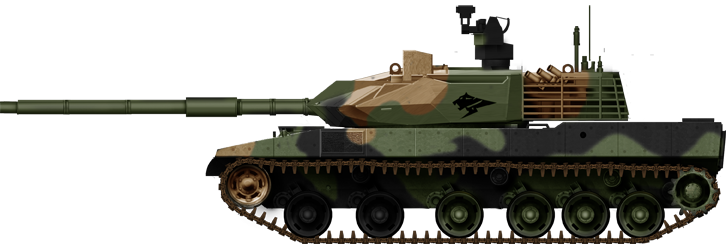
ZTQ-15 prototype, without its side skirts. As it seems, without identification number and the model logo, a black panther.
The turret superficially looked like to a lightened moded used on the VT-4. But after making the illustration, it appeared larger in all directions, possibly because of additional modular blocks. The ZTQ-15 is scheduled to replace completely the 1960s Type 62 light tank, including the Type 62G derivative. The core of the concept is a Chinese-made ZPT-83-II 'long barrel' 105 mm rifled cannon closely derived on NATO's own legendary L7 piece of ordnance, widely adopted in the late 1970s and 1980s for the new generation MBTs that transitioned towards the Type-90/96, such as the Type-69/79, and Type-80/88 and Type-59 upgrades.
The ZTQ-15 has been almost a shock for US Intelligence when it was revealed since nothing laked about it up until recently. It has been spotted in at least three main versions, including a basic one possibly the army prototype, very close to the serial production, a fully armored type, a marine type, and an export type called VT5. Since, the ZTQ-15 (introduced in 2015) has been dubbed the "mountain tank" and it has been devised mainly for the southern China sector, both hilly, mountainous and wet, calling for a light tank.
In a nutshell, the ZTQ-15 designed by the 201 institute and revealed by a CCTV documentary existed into two forms, a first 201 prototype and the pre-serie prototype 617 which has a different hull and turret shapes (notably the rear step over the engine). It is a jungle/swamp model also capable of dealing with the great heights of Tibet with an engine tailored to work in low oxygen conditions according to huanqiu.com. The weight should be around 30 tons, much more than the old Type 62, it features a hydropneumatic suspension to deal with the most unforgiving terrain, is able to defeat (with APFSDS) any T-55 or T-72 that can be thrown at it from Vietnam or India, is more easy to transport and amphibious although non-floating (so preparations needed and depth limited), and it is likely the chassis has been studied to be reused on a large variety of light vehicles well suited for many export deals.
Misc.
 Type 89 tank destroyer
Type 89 tank destroyer
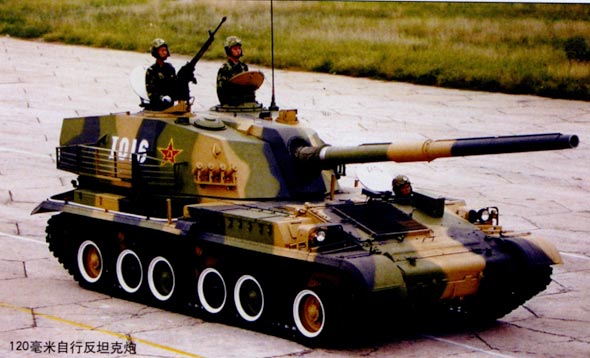
100 built until 1995. 120 millimeter smoothbore gun. Transitional model abandoned after the end of the cold war. Other TDs were later built on the WZ551 wheeled vehicle.
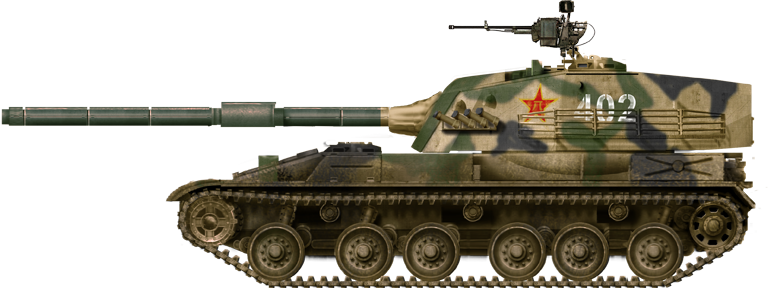
Illustration of the Type 89 Tank destroyer by David Bocquelet
Type 85/89 IFVs (1990)

These are vehicles derived from the Type 63 APC, but with a conception that looks much at the Russian BMP-3 family.
 ZBD-97 IFV (2006)
ZBD-97 IFV (2006)
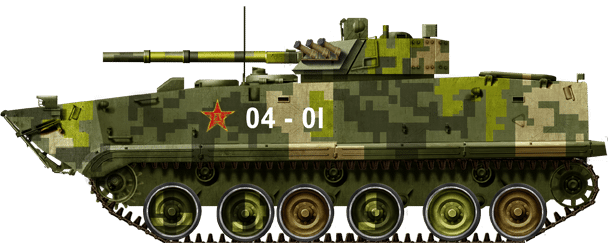
Tracked. 400 vehicles.
 ZBD-2000 IFV (2006)
ZBD-2000 IFV (2006)
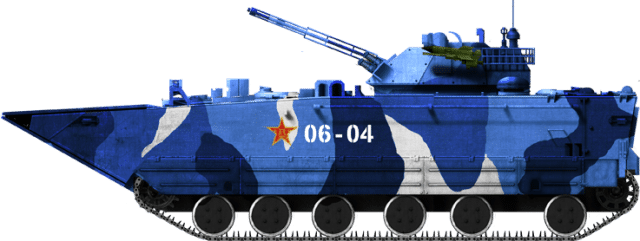
ZBD 2000 in parade colours, Bejing 2006.
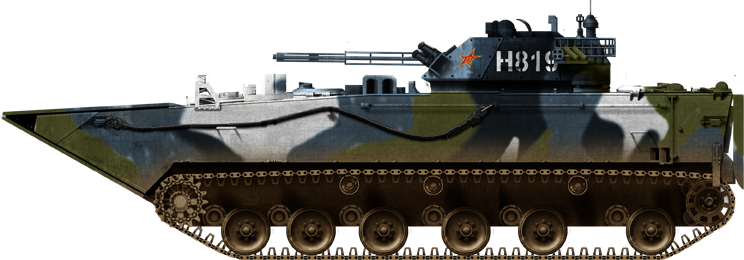
ZBD 05 light tank in marine camouflage
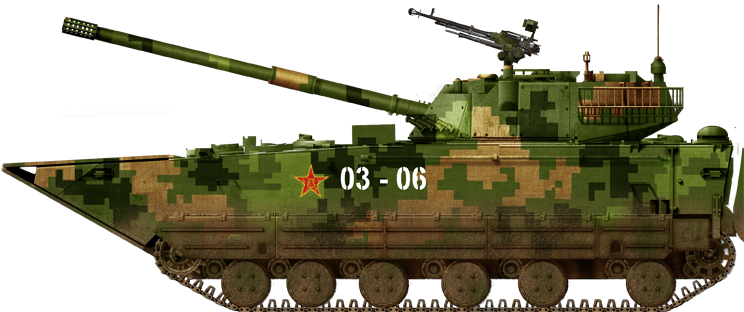
ZBD 05/105 with an inland digital type camouflage.
 ZBD-09
ZBD-09
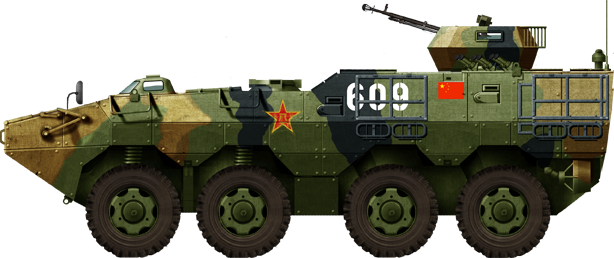
ZBL-09 Armoured Personal Carrier
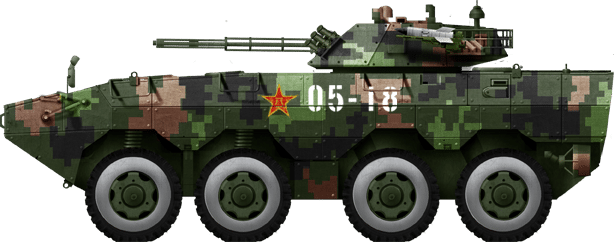
ZBD-09 IFV, digital camouflage livery
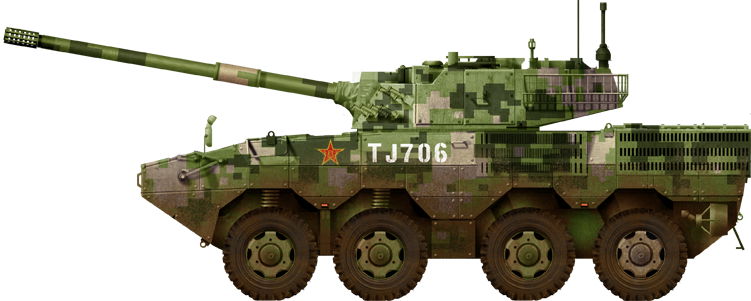
ZBD-09 105mm antitank/infantry support version
 Type 83 self-propelled howitzer
Type 83 self-propelled howitzer
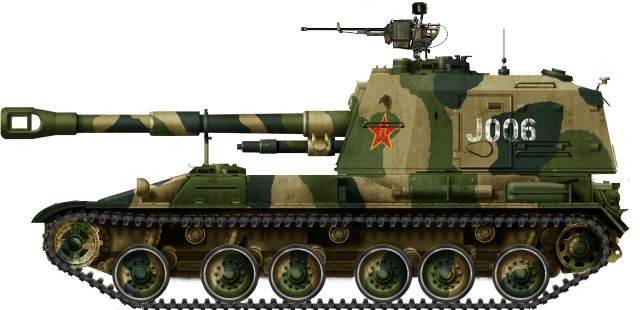
 PLZ-05
PLZ-05

PLZ 05 (Type 88) self propelled gun
 PLZ-07
PLZ-07
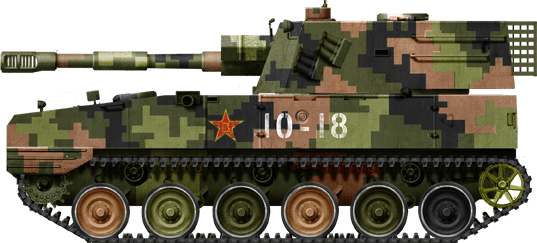
PLZ-07
 PHZ-89
PHZ-89
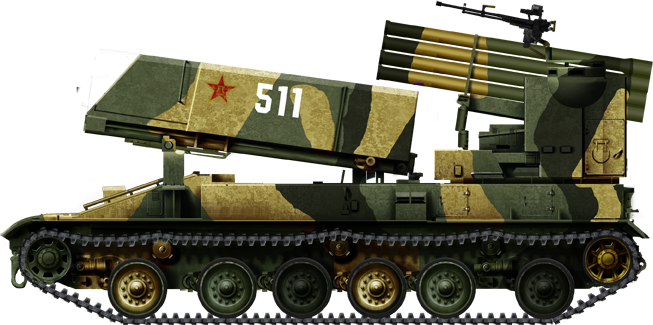
The PHZ-89 or Type 89 SPRML is a 122-mm rocket launcher tank based on the multi-purpose chassis also used by the Type 83 152-mm howitzer and Type 89 tank hunter. Chinese artillery corps have a dozen of unarmored trucks for this task, but the Type 89 was built specifically to be organically part of mobile frontline units, armored troops of the PLA and therefore has a high level of protection. The base launching system was developed from the Type 81 and it was first revealed publicly in 1999. It replaced the older Type 70 130-mm SPRML, and bears 40 launching tubes stacked at the rear. The massive box at the front is for reloads. So the vehicle can fire two volleys before it needs resupplying, which is done hydraulically in 2 minutes. The fire is assisted by sensors and a digital fire control system while the rockets can be fitted with a variety of warheads.
 Hongki-HQ7B
Hongki-HQ7B
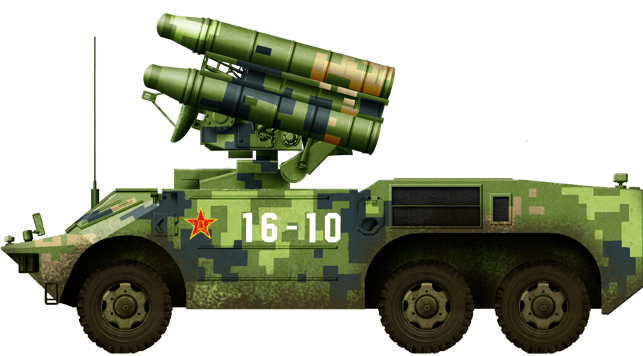
The 6x6 variant. Not difficult to spot here are four unlicenced copies of the Crotale short range SAM, after China first imported the Thomson-CSF Crotale missile in 1978-1979 for "evaluation". Hóng qí means "red flag" or "red banner". It was first used on the Type 052 destroyers (Luhu class). Thee institutes reverse-engineered all the systems and the HQ-7 was first tested in 1983, while production started in 1986-88, in two versions. The first called FM-80 was land-based and generally deployed around PLAGF airfields and PLA bases. The self-propelled 4x4 TELAR vehicle on a cloned Thomson-Hotchkiss P4R chassis was created by the 206th Institute and more recently, while in 1998 the HQ-7A (FM-90) for export made its debut. However around 2006 a new version appeared, the 6x6 HQ-7B. It was revealed in 2009 with and indigenous 6x6 armored chassis, and exported as the FM-90 (Pakistan purchased it).
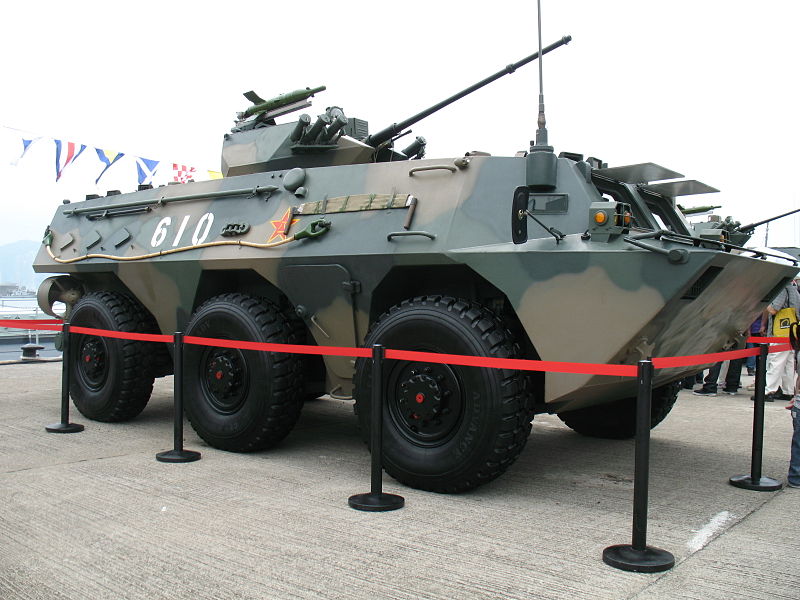
 WZ551 Type 90/92 APC (1995)
WZ551 Type 90/92 APC (1995)
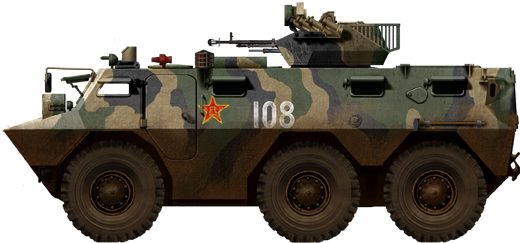
WZ523 APC (1984). This vehicle was also declined into the ZLS-92 export variant, but without much sales successes.
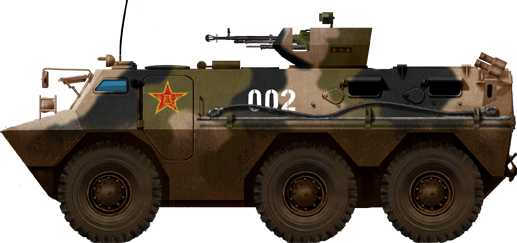
Type-90 APC, also known as the initial WZ551 serie. It was later upgraded as the NGV-1 with a 25 mm autocannon.
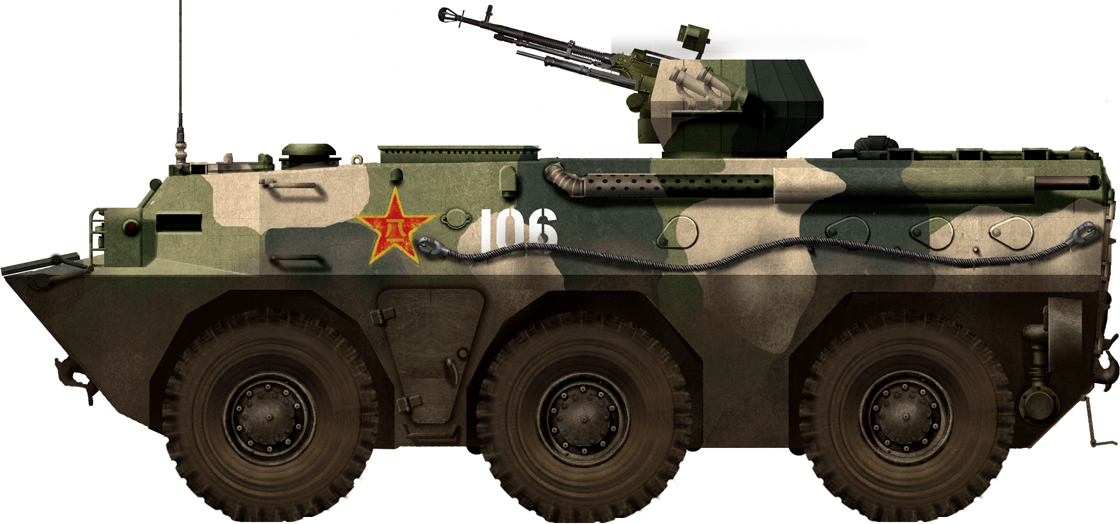
Type-90B APC (1997), armed with the 12.7 mm HMG.
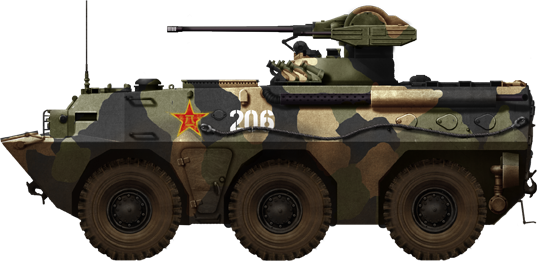
Type-90A IFV (1995), armed with the 25 mm autocannon.
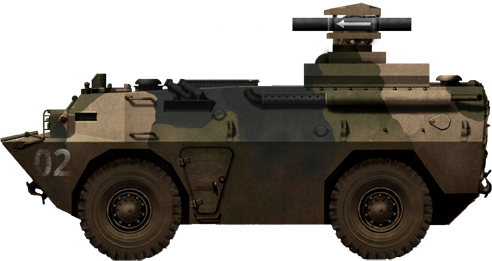
WZ550 HJ-9 ATGM carrier/launcher, the standard 4x4 tank hunter variant.
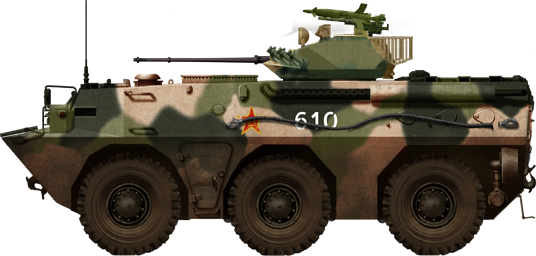
Type 92B /ZSL-92B APC (WZ-551B), an improved version fitted with a 20 mm automatic cannon
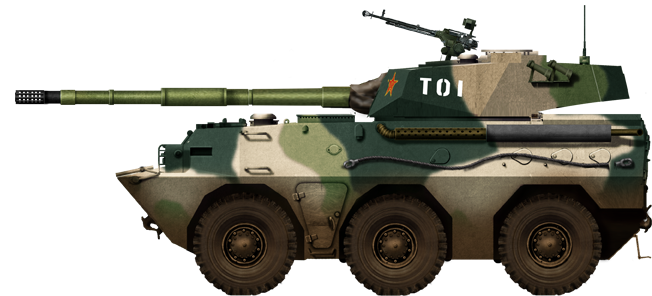
PTL-02 Tank Hunter, self-propelled assault gun, with the Type 86 100mm high velocity smoothbore cannon.
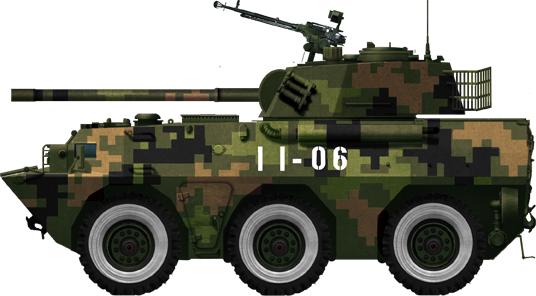
Chinese PLA PLL-05 self-propelled 120mm gun-mortar at the 2011 Beijing military parade (introduced 2001).
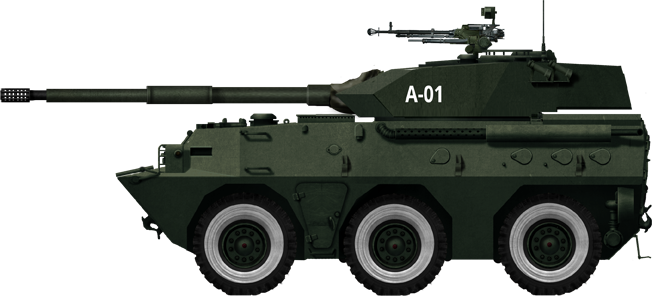
Sri Lanka Army WMA301 Assaulter tank hunter with a NATO 105 mm gun
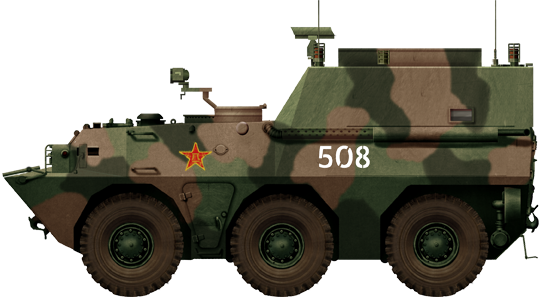
WZ551 Command post. It has been exported and is used by nations such as Senegal, alongside another succesful export, the WMA-301 Assaulter.
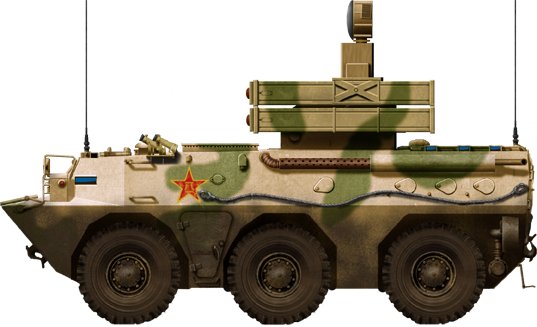
The Yitian SPAAML is an Air defense upgrade with TY-90 AA missile launcher (close to the American AN/TWQ-1 Avenger), radar and thermal-tracking sight.

Modern Tanks
Modern MBTs posters

Denel Bagder (2018)

Type 16 MCV (2016)

Gepard 1A2 last rounds 2011

SANDF

Russian AFVs

Main Battle Tanks

